engine FIAT DUCATO BASE CAMPER 2015 Owner handbook (in English)
[x] Cancel search | Manufacturer: FIAT, Model Year: 2015, Model line: DUCATO BASE CAMPER, Model: FIAT DUCATO BASE CAMPER 2015Pages: 367, PDF Size: 19.73 MB
Page 235 of 367
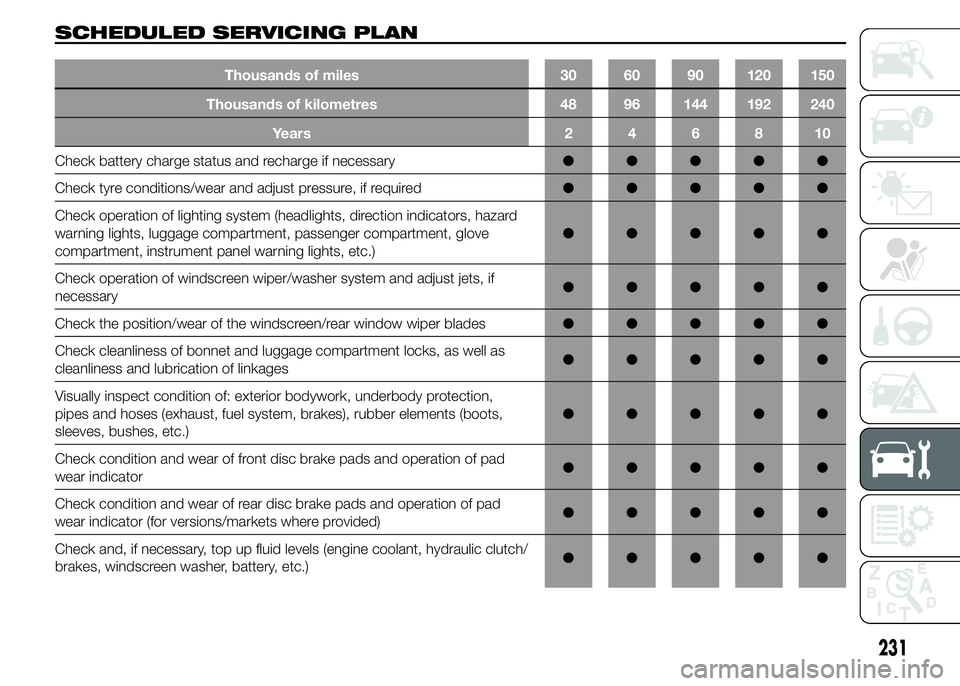
SCHEDULED SERVICING PLAN
Thousands of miles 30 60 90 120 150
Thousands of kilometres 48 96 144 192 240
Years246810
Check battery charge status and recharge if necessary●●●●●
Check tyre conditions/wear and adjust pressure, if required●●●●●
Check operation of lighting system (headlights, direction indicators, hazard
warning lights, luggage compartment, passenger compartment, glove
compartment, instrument panel warning lights, etc.)●●●●●
Check operation of windscreen wiper/washer system and adjust jets, if
necessary●●●●●
Check the position/wear of the windscreen/rear window wiper blades●●●●●
Check cleanliness of bonnet and luggage compartment locks, as well as
cleanliness and lubrication of linkages●●●●●
Visually inspect condition of: exterior bodywork, underbody protection,
pipes and hoses (exhaust, fuel system, brakes), rubber elements (boots,
sleeves, bushes, etc.)●●●●●
Check condition and wear of front disc brake pads and operation of pad
wear indicator●●●●●
Check condition and wear of rear disc brake pads and operation of pad
wear indicator (for versions/markets where provided)●●●●●
Check and, if necessary, top up fluid levels (engine coolant, hydraulic clutch/
brakes, windscreen washer, battery, etc.)●●●●●
231
Page 236 of 367
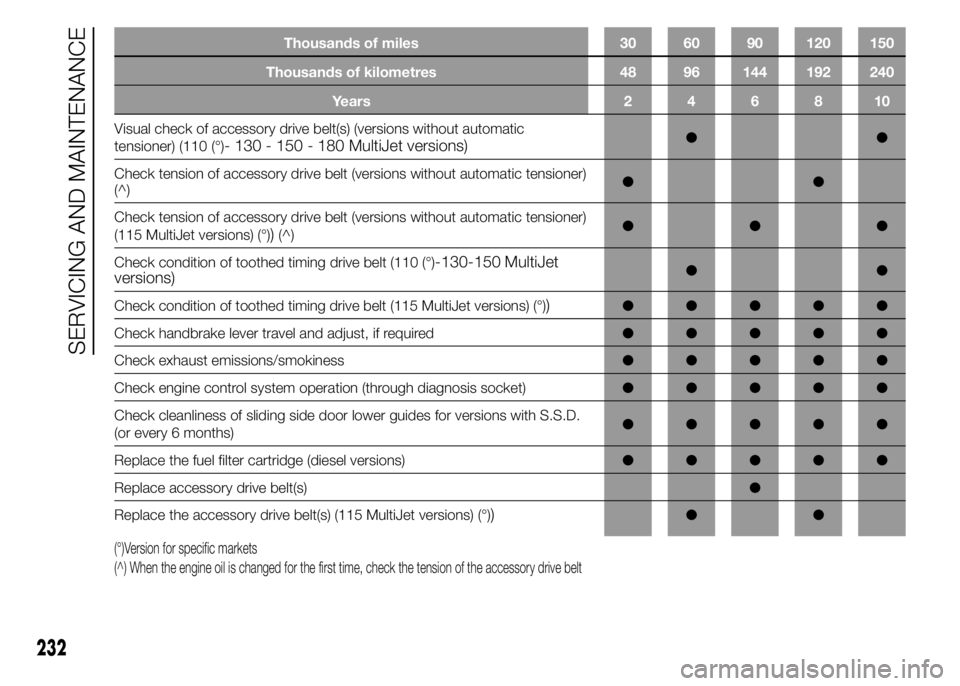
Thousands of miles 30 60 90 120 150
Thousands of kilometres 48 96 144 192 240
Years246810
Visual check of accessory drive belt(s) (versions without automatic
tensioner) (110 (°)
- 130 - 150 - 180 MultiJet versions)●●
Check tension of accessory drive belt (versions without automatic tensioner)
(^)●●
Check tension of accessory drive belt (versions without automatic tensioner)
(115 MultiJet versions) (°)
)(^)●●●
Check condition of toothed timing drive belt (110 (°)
-130-150 MultiJet
versions)●●
Check condition of toothed timing drive belt (115 MultiJet versions) (°)
)●●●●●
Check handbrake lever travel and adjust, if required●●●●●
Check exhaust emissions/smokiness●●●●●
Check engine control system operation (through diagnosis socket)●●●●●
Check cleanliness of sliding side door lower guides for versions with S.S.D.
(or every 6 months)●●●●●
Replace the fuel filter cartridge (diesel versions)●●●●●
Replace accessory drive belt(s)●
Replace the accessory drive belt(s) (115 MultiJet versions) (°)
)●●
(°)Version for specific markets
(^) When the engine oil is changed for the first time, check the tension of the accessory drive belt
232
SERVICING AND MAINTENANCE
Page 237 of 367
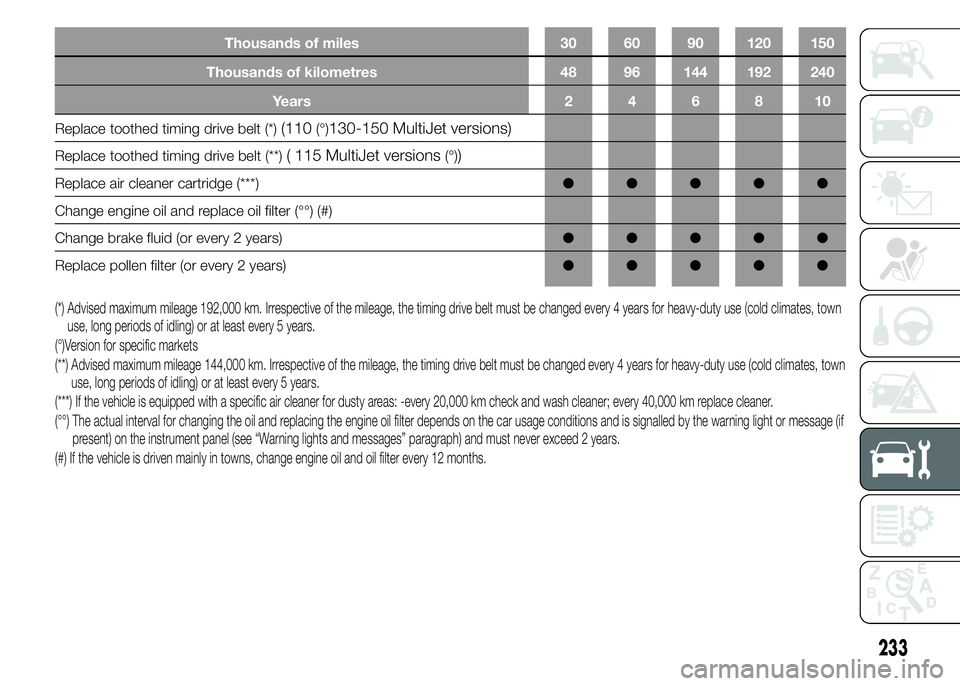
Thousands of miles 30 60 90 120 150
Thousands of kilometres 48 96 144 192 240
Years246810
Replace toothed timing drive belt (*)(110(°)130-150 MultiJet versions)
Replace toothed timing drive belt (**)( 115 MultiJet versions(°))
Replace air cleaner cartridge (***)●●●●●
Change engine oil and replace oil filter (°°) (#)
Change brake fluid (or every 2 years)●●●●●
Replace pollen filter (or every 2 years)●●●●●
(*) Advised maximum mileage 192,000 km. Irrespective of the mileage, the timing drive belt must be changed every 4 years for heavy-duty use (cold climates, town
use, long periods of idling) or at least every 5 years.
(°)Version for specific markets
(**) Advised maximum mileage 144,000 km. Irrespective of the mileage, the timing drive belt must be changed every 4 years for heavy-duty use (cold climates, town
use, long periods of idling) or at least every 5 years.
(***) If the vehicle is equipped with a specific air cleaner for dusty areas: -every 20,000 km check and wash cleaner; every 40,000 km replace cleaner.
(°°) The actual interval for changing the oil and replacing the engine oil filter depends on the car usage conditions and is signalled by the warning light or message (if
present) on the instrument panel (see “Warning lights and messages” paragraph) and must never exceed 2 years.
(#) If the vehicle is driven mainly in towns, change engine oil and oil filter every 12 months.
233
Page 238 of 367
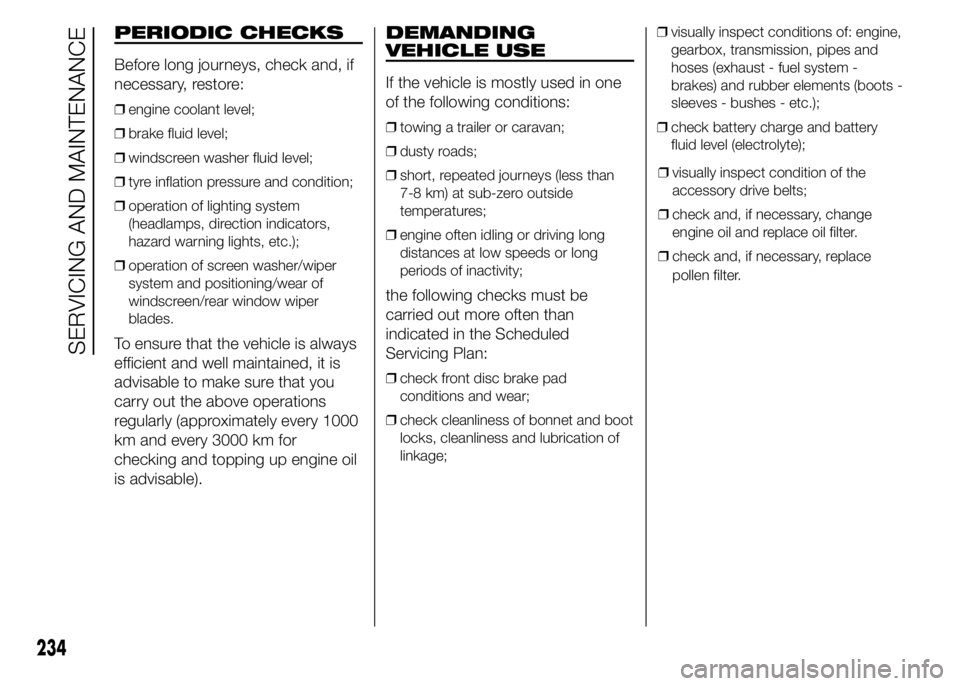
PERIODIC CHECKS
Before long journeys, check and, if
necessary, restore:
❒engine coolant level;
❒brake fluid level;
❒windscreen washer fluid level;
❒tyre inflation pressure and condition;
❒operation of lighting system
(headlamps, direction indicators,
hazard warning lights, etc.);
❒operation of screen washer/wiper
system and positioning/wear of
windscreen/rear window wiper
blades.
To ensure that the vehicle is always
efficient and well maintained, it is
advisable to make sure that you
carry out the above operations
regularly (approximately every 1000
km and every 3000 km for
checking and topping up engine oil
is advisable).
DEMANDING
VEHICLE USE
If the vehicle is mostly used in one
of the following conditions:
❒towing a trailer or caravan;
❒dusty roads;
❒short, repeated journeys (less than
7-8 km) at sub-zero outside
temperatures;
❒engine often idling or driving long
distances at low speeds or long
periods of inactivity;
the following checks must be
carried out more often than
indicated in the Scheduled
Servicing Plan:
❒check front disc brake pad
conditions and wear;
❒check cleanliness of bonnet and boot
locks, cleanliness and lubrication of
linkage;❒visually inspect conditions of: engine,
gearbox, transmission, pipes and
hoses (exhaust - fuel system -
brakes) and rubber elements (boots -
sleeves - bushes - etc.);
❒check battery charge and battery
fluid level (electrolyte);
❒visually inspect condition of the
accessory drive belts;
❒check and, if necessary, change
engine oil and replace oil filter.
❒check and, if necessary, replace
pollen filter.
234
SERVICING AND MAINTENANCE
Page 239 of 367
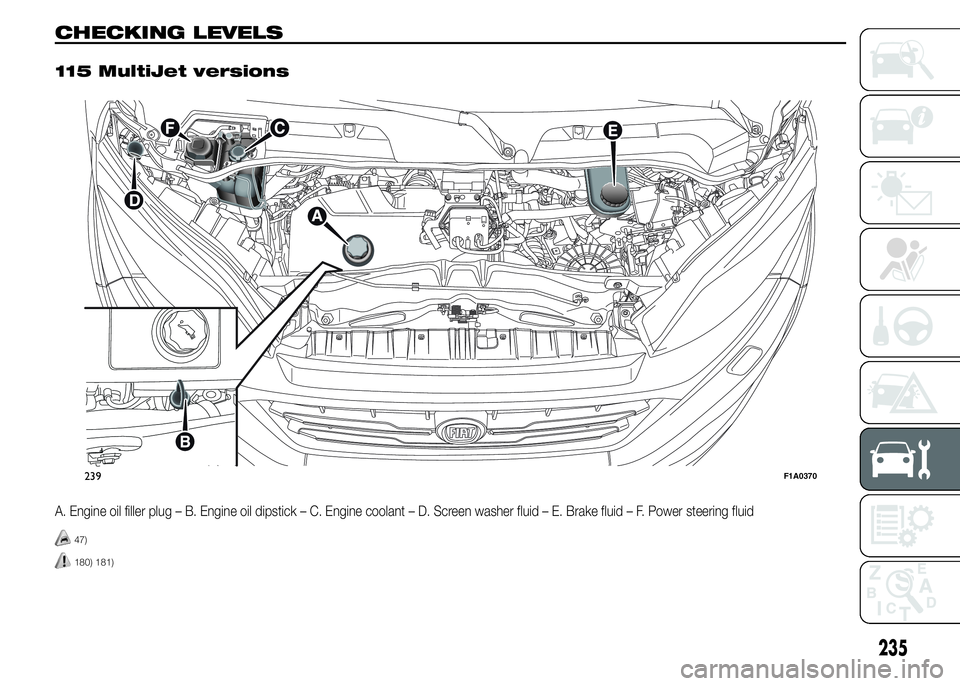
CHECKING LEVELS.
115 MultiJet versions
A. Engine oil filler plug – B. Engine oil dipstick – C. Engine coolant – D. Screen washer fluid – E. Brake fluid – F. Power steering fluid
47)
180) 181)
239F1A0370
235
Page 240 of 367
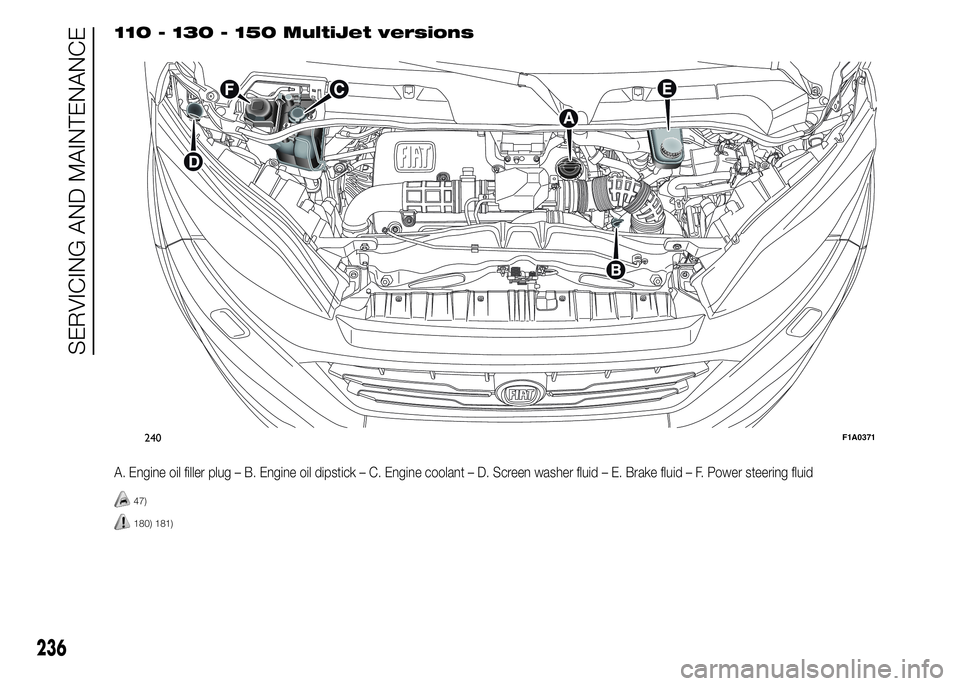
110 - 130 - 150 MultiJet versions
A. Engine oil filler plug – B. Engine oil dipstick – C. Engine coolant – D. Screen washer fluid – E. Brake fluid – F. Power steering fluid
47)
180) 181)
240F1A0371
236
SERVICING AND MAINTENANCE
Page 241 of 367
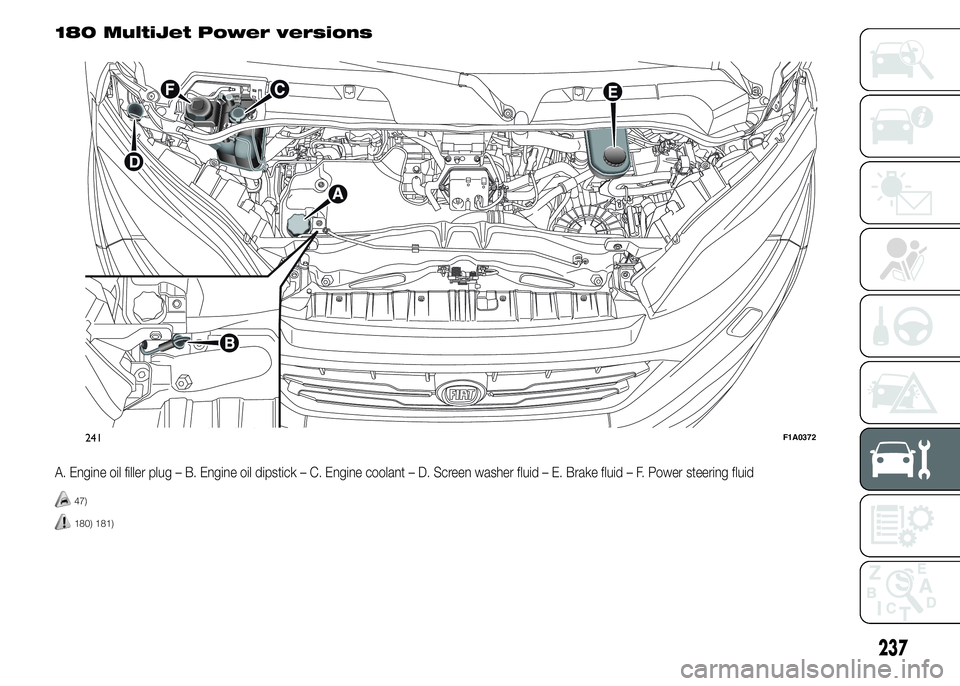
180 MultiJet Power versions
A. Engine oil filler plug – B. Engine oil dipstick – C. Engine coolant – D. Screen washer fluid – E. Brake fluid – F. Power steering fluid
47)
180) 181)
241F1A0372
237
Page 242 of 367
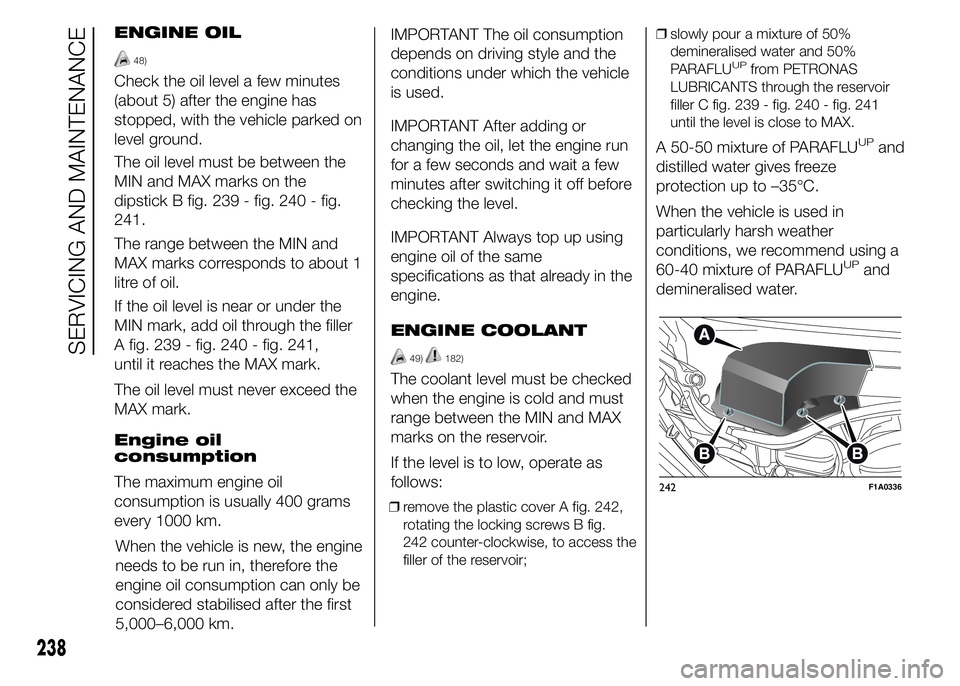
ENGINE OIL
48)
Check the oil level a few minutes
(about 5) after the engine has
stopped, with the vehicle parked on
level ground.
The oil level must be between the
MIN and MAX marks on the
dipstick B fig. 239 - fig. 240 - fig.
241.
The range between the MIN and
MAX marks corresponds to about 1
litre of oil.
If the oil level is near or under the
MIN mark, add oil through the filler
A fig. 239 - fig. 240 - fig. 241,
until it reaches the MAX mark.
The oil level must never exceed the
MAX mark.
Engine oil
consumption
The maximum engine oil
consumption is usually 400 grams
every 1000 km.
When the vehicle is new, the engine
needs to be run in, therefore the
engine oil consumption can only be
considered stabilised after the first
5,000–6,000 km.IMPORTANT The oil consumption
depends on driving style and the
conditions under which the vehicle
is used.
IMPORTANT After adding or
changing the oil, let the engine run
for a few seconds and wait a few
minutes after switching it off before
checking the level.
IMPORTANT Always top up using
engine oil of the same
specifications as that already in the
engine.
ENGINE COOLANT
49)182)
The coolant level must be checked
when the engine is cold and must
range between the MIN and MAX
marks on the reservoir.
If the level is to low, operate as
follows:
❒remove the plastic cover A fig. 242,
rotating the locking screws B fig.
242 counter-clockwise, to access the
filler of the reservoir;❒slowly pour a mixture of 50%
demineralised water and 50%
PARAFLU
UPfrom PETRONAS
LUBRICANTS through the reservoir
filler C fig. 239 - fig. 240 - fig. 241
until the level is close to MAX.
A 50-50 mixture of PARAFLUUPand
distilled water gives freeze
protection up to –35°C.
When the vehicle is used in
particularly harsh weather
conditions, we recommend using a
60-40 mixture of PARAFLU
UPand
demineralised water.
242F1A0336
238
SERVICING AND MAINTENANCE
Page 243 of 367
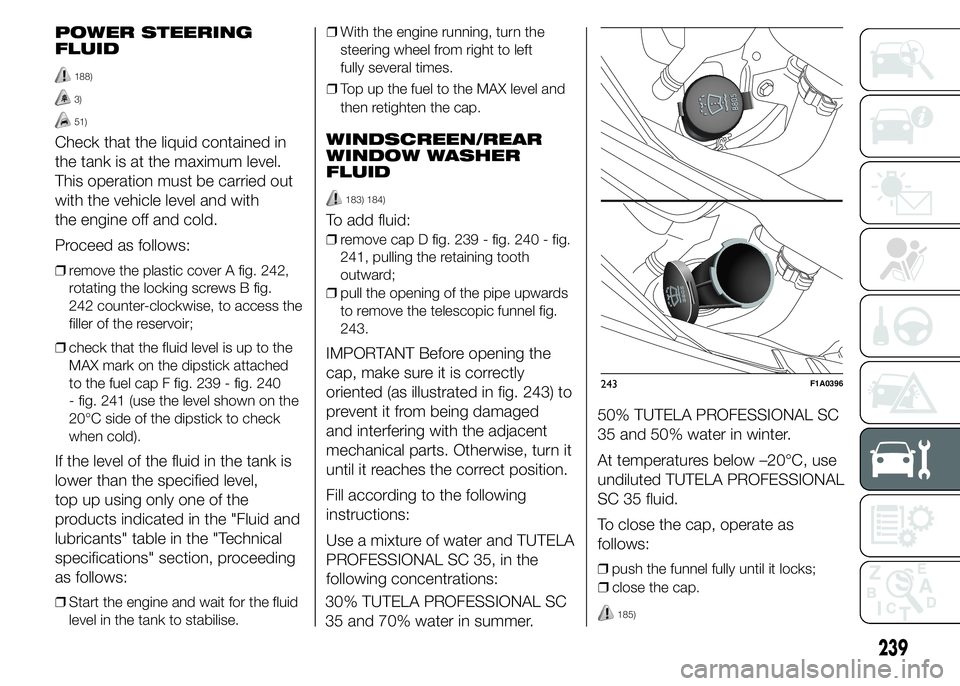
POWER STEERING
FLUID
188)
3)
51)
Check that the liquid contained in
the tank is at the maximum level.
This operation must be carried out
with the vehicle level and with
the engine off and cold.
Proceed as follows:
❒remove the plastic cover A fig. 242,
rotating the locking screws B fig.
242 counter-clockwise, to access the
filler of the reservoir;
❒check that the fluid level is up to the
MAX mark on the dipstick attached
to the fuel cap F fig. 239 - fig. 240
- fig. 241 (use the level shown on the
20°C side of the dipstick to check
when cold).
If the level of the fluid in the tank is
lower than the specified level,
top up using only one of the
products indicated in the "Fluid and
lubricants" table in the "Technical
specifications" section, proceeding
as follows:
❒Start the engine and wait for the fluid
level in the tank to stabilise.❒With the engine running, turn the
steering wheel from right to left
fully several times.
❒Top up the fuel to the MAX level and
then retighten the cap.
WINDSCREEN/REAR
WINDOW WASHER
FLUID
183) 184)
To add fluid:
❒remove cap D fig. 239 - fig. 240 - fig.
241, pulling the retaining tooth
outward;
❒pull the opening of the pipe upwards
to remove the telescopic funnel fig.
243.
IMPORTANT Before opening the
cap, make sure it is correctly
oriented (as illustrated in fig. 243) to
prevent it from being damaged
and interfering with the adjacent
mechanical parts. Otherwise, turn it
until it reaches the correct position.
Fill according to the following
instructions:
Use a mixture of water and TUTELA
PROFESSIONAL SC 35, in the
following concentrations:
30% TUTELA PROFESSIONAL SC
35 and 70% water in summer.50% TUTELA PROFESSIONAL SC
35 and 50% water in winter.
At temperatures below –20°C, use
undiluted TUTELA PROFESSIONAL
SC 35 fluid.
To close the cap, operate as
follows:
❒push the funnel fully until it locks;
243F1A0396
239
❒close the cap.
185)
Page 244 of 367
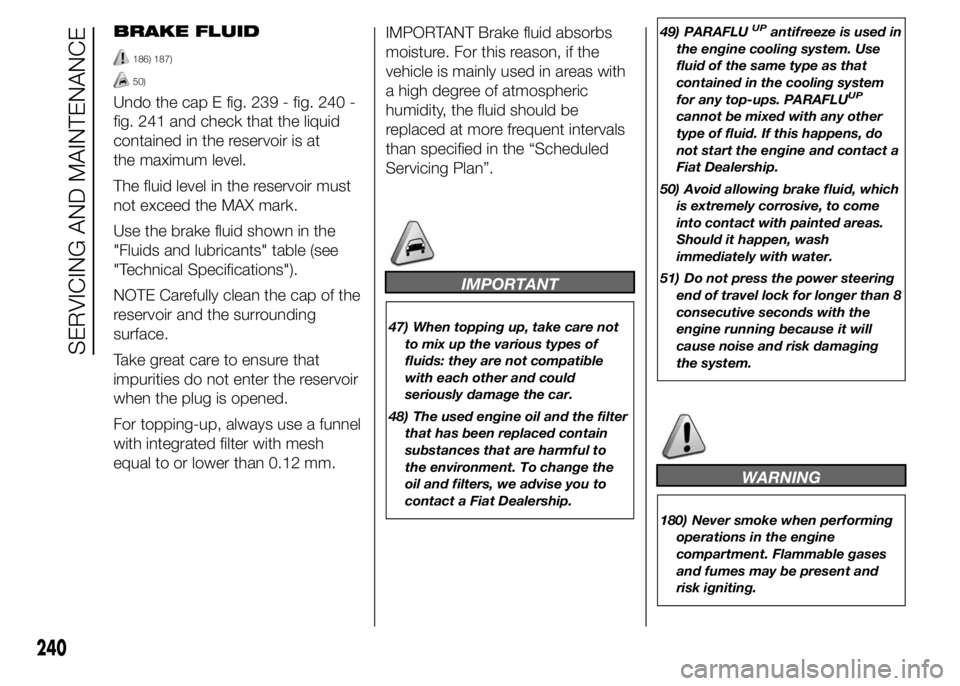
BRAKE FLUID
186) 187)
50)
Undo the cap E fig. 239 - fig. 240 -
fig. 241 and check that the liquid
contained in the reservoir is at
the maximum level.
The fluid level in the reservoir must
not exceed the MAX mark.
Use the brake fluid shown in the
"Fluids and lubricants" table (see
"Technical Specifications").
NOTE Carefully clean the cap of the
reservoir and the surrounding
surface.
Take great care to ensure that
impurities do not enter the reservoir
when the plug is opened.
For topping-up, always use a funnel
with integrated filter with mesh
equal to or lower than 0.12 mm.IMPORTANT Brake fluid absorbs
moisture. For this reason, if the
vehicle is mainly used in areas with
a high degree of atmospheric
humidity, the fluid should be
replaced at more frequent intervals
than specified in the “Scheduled
Servicing Plan”.
IMPORTANT
47) When topping up, take care not
to mix up the various types of
fluids: they are not compatible
with each other and could
seriously damage the car.
48) The used engine oil and the filter
that has been replaced contain
substances that are harmful to
the environment. To change the
oil and filters, we advise you to
contact a Fiat Dealership.49) PARAFLU
UPantifreeze is used in
the engine cooling system. Use
fluid of the same type as that
contained in the cooling system
for any top-ups. PARAFLU
UP
cannot be mixed with any other
type of fluid. If this happens, do
not start the engine and contact a
Fiat Dealership.
50) Avoid allowing brake fluid, which
is extremely corrosive, to come
into contact with painted areas.
Should it happen, wash
immediately with water.
51) Do not press the power steering
end of travel lock for longer than 8
consecutive seconds with the
engine running because it will
cause noise and risk damaging
the system.
WARNING
180) Never smoke when performing
operations in the engine
compartment. Flammable gases
and fumes may be present and
risk igniting.
240
SERVICING AND MAINTENANCE